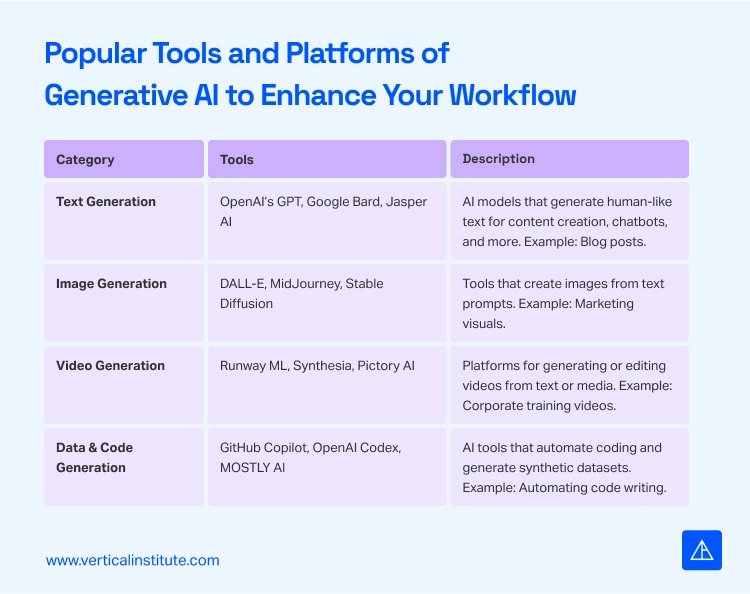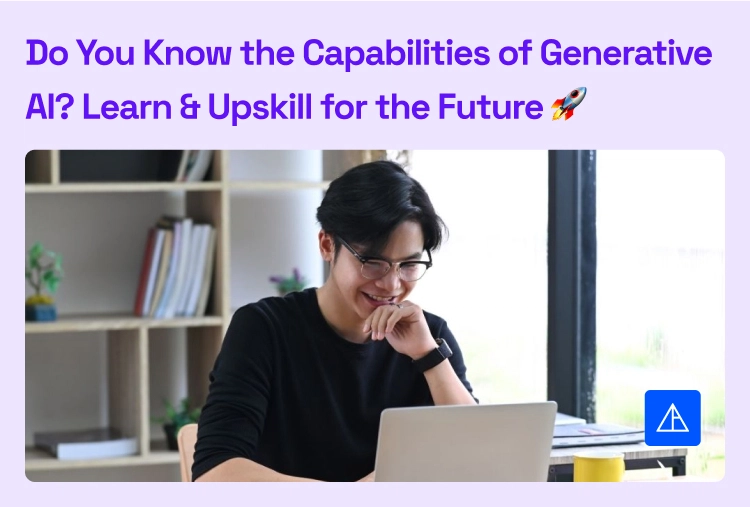The relevance of generative AI has surged across industries like media, healthcare, marketing, and technology. According to McKinsey, it could add $2.6 to $4.4 trillion annually to the global economy by transforming how businesses create and use data, scaling content production, personalising customer experiences, and streamlining operations. Additionally, TechTarget notes that its ability to generate synthetic data or fill gaps in datasets enhances data analytics, providing better insights and innovation for businesses reliant on large data volumes.
In this article, we will explore the key capabilities and tools of generative AI, including its ability to generate text, images, audio, video, code, and synthetic data, as well as enhance existing content. We’ll also examine how AI is creating immersive virtual worlds, particularly in gaming and virtual reality. Additionally, we will highlight essential tools like OpenAI’s GPT for text, DALL-E for images, and other platforms, providing professionals and businesses with insights on using these technologies to enhance efficiency and innovation.
Related: Boost Your Career with AI and Analytics Skills: Here’s Why It Matters
What are the Core Capabilities of Generative AI?
Below are some of generative AI’s most prominent abilities, demonstrating its versatility and far-reaching impact:
1. Text Generation
Generative AI models like OpenAI’s GPT have transformed text creation by producing human-like language. They learn from vast datasets to understand context, structure, and style. This allows them to create realistic writing. These models are used for automating chatbots, writing blog content, summarising documents, and translating languages. They can also generate creative pieces like stories and poems.
Use Cases
- Content creation for blogs, websites, and social media
- Automated chatbots for customer service
- Summarisation of lengthy reports and documents
- Language translation for businesses
Example Tools
- GPT by OpenAI
- Google Bard
- Jasper AI
2. Image Generation
Generative AI also excels in creating images from text prompts or minimal input, producing anything from realistic photos to abstract art. These models analyse vast visual datasets to understand patterns, colours, and shapes, enabling them to generate images that meet specific requirements. This technology is widely used in creative industries, where it helps designers and marketers rapidly generate visuals without needing extensive graphic design expertise.
Use Cases
- Graphic design for marketing and branding
- Product mock-ups and virtual product displays
- Concept art for film, games, and advertising
- Personalised content for social media campaigns
Example Tools
- DALL-E
- MidJourney
- Stable Diffusion
3. Audio Generation
Generative AI can produce high-quality audio, including soundscapes, voice synthesis, and even full music compositions. These models learn from large datasets of sounds and music, enabling them to compose original audio tracks or accurately mimic human voices. This is particularly useful in industries like entertainment and marketing, where customised sound and music are essential.
Use Cases
- Music composition for films, games, and advertisements
- Voiceover generation for videos and podcasts
- Audio branding for companies
- Assistive technology for speech synthesis
Example Tools
- AIVA
- Resemble AI
- OpenAI’s Jukebox
4. Video Generation
Generative AI extends its capabilities to video creation, enabling the production of videos based on text descriptions or minimal inputs. AI can generate entire video sequences or animations or enhance existing footage, making it easier for creators to produce engaging content quickly and cost-effectively.
Use Cases
- Advertising and promotional videos
- Educational videos and tutorials
- AI-assisted film production
- Content marketing for social media
Example Tools
- Runway ML
- Synthesia
- Pictory AI
5. Synthetic Data Generation
Generative AI’s ability to create synthetic datasets offers valuable solutions for businesses that rely on data for training machine learning models. It is particularly useful when real data is limited, costly, or sensitive. By generating synthetic data that replicates real-world datasets, AI allows companies to bypass data limitations while protecting privacy.
Use Cases
- Training machine learning models without risking data privacy
- Generating datasets for healthcare, finance, and research
- Expanding limited datasets for testing algorithms
Example Tools
- MOSTLY AI
- Gretel.ai
- Tonic.ai
6. Code Generation
AI’s code generation capability transforms software development by automatically generating functioning code from simple text prompts. This significantly speeds up development processes, automates repetitive coding tasks, and helps developers focus on more complex work. By learning from vast code repositories, AI models can suggest or even write entire code blocks, reducing the need for manual coding.
Use Cases
- Assisting developers with code suggestions
- Automating routine coding tasks
- Accelerating software development
- Reducing coding errors and improving code quality
Example Tools
- GitHub Copilot
- OpenAI Codex
- Tabnine
7. Augmentation Capability
Generative AI also augment and enhance existing content, improving the quality or utility of data and media. It can fill gaps in incomplete datasets, improve the resolution of images, or refine content for better marketing results.
Use Cases
- Enhancing low-resolution images or videos
- Improving incomplete datasets for better machine learning outcomes
- Enriching content for academic, research, or marketing purposes
Example Tools
- Adobe Sensei
- Topaz Labs
- Neural Love
8. Creation of Real and Immersive Virtual Worlds
Generative AI is driving the development of immersive virtual environments for gaming, simulations, and education. By generating lifelike or fantastical virtual worlds, AI enhances user experiences in various digital spaces, from virtual reality (VR) gaming to architectural simulations.
Use Cases
- Virtual reality (VR) games
- Architectural and Urban Planning simulations
- Digital twins for industrial applications
- Enhanced experiences in the metaverse
Example Tools:
- Unreal Engine (with AI integration)
- NVIDIA Omniverse
- OpenAI’s GPT-4 in interactive platforms
What are the Popular Tools and Platforms of Generative AI?
Generative AI has become more accessible to professionals and businesses, with various tools available for text, image, video, and data generation. These user-friendly tools can easily be integrated into workflows, enhancing productivity, creativity, and efficiency across various industries.

Conclusion
The integration of generative AI into our workflows is an inevitable step forward. These tools, from text and image generation to code automation and synthetic data creation, are fundamentally changing how we approach tasks, making work more efficient and freeing up time for innovation. By adopting AI, businesses can streamline processes and improve output. However, upskilling is crucial to harness these advancements fully.
Vertical Institute offers certification courses in AI-enhanced fields like Data Science, Generative AI, UI/UX Design, Cybersecurity, Data Analytics, Blockchain and Digital Marketing. These programmes equip professionals with the in-demand skills needed to excel in an AI-driven job market, ensuring you stay competitive as industries evolve. Explore how you can prepare for the next step in your career today.
About Vertical Institute
Vertical Institute is revolutionising the future of work by empowering individuals with essential skills to excel in today’s evolving job market. Our comprehensive courses and certifications are designed to cultivate vital skills and nurture the next generation of visionaries and trailblazers.
As a certified Approved Training Provider (ATO) recognised by SkillsFuture Singapore (SSG) and the Institute of Banking & Finance Singapore (IBF), Vertical Institute offers state-of-the-art, government-subsidised tech courses. Participants in our programs are eligible for SkillsFuture Credits and NTUC UTAP funding, which helps alleviate education costs.



